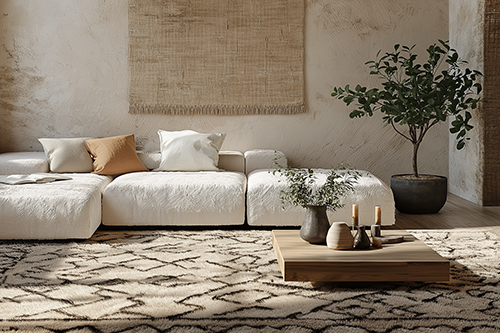Moroccan Tribal Rug Weaving At It's Best - The Humble Berber Rug
Posted by Nick Pole on 1st Jun 2016

Each Moroccan Berber rug is really a story, a time capsule complete with
myth and legend, handed down through untold eons of history. Remote and
isolated, Berber weavers of the past had no standardized written
language, so they recorded their distant origins by writing in wool,
weaving time into rug patterns. The transference of symbolic glyphs and
markings knotted into Berber rugs repeat the earliest forms of cave
paintings and rock figures.
Berber rugs are an act of personal expression, like all art. Rug weaving
is a traditional woman's role, and the rugs often symbolize women's
primal activities, such as coming of age, fertility, birth and the
protective love of men. Other weaving's convey an ancestral awareness, a
spirit of oneness with living wool and the earth, channeling long-ago
peoples through the skill of the weaver. In fact, many Berber women
believe that completed rugs are imbued with a spirit, and they refuse
patterning and blue-printing of their expression.
Even the wool is said to have mystic, protective powers. The rugs' organic colors from saffron, indigo and madder root dyes each
have a meaning. Red represents strength and protection, green, peace,
blue, wisdom and yellow, the eternal. These colors are used to protect
the rug's owner from negativity and to focus the spirit. For untold
eons, Berber women have woven ancestral presence and wisdom into their
rugs and used them for flooring, saddle blankets, cushions - and their
final burial shrouds.
Berbers are an indigenous people of North Africa who have dwelt in the
high mountains of Morocco for centuries. The origins of their carpet
weaving dates back to the very dawn of time, the Paleolithic era. The
harsh deserts of the Sahara inspired light, flat-weave pieces, while the
wild, wind-swept Atlas Mountains made for heavy-pile bed coverings and
sleeping mats.
The Berber's nomadic existence prompted the size of their rugs and mats,
as the looms and their pieces need to be portable. This kept the
maximum rug size at seven feet.
Paradoxically, the Berber rug's mystic symbolism and strange
transference of ancestral memory captured the imaginations of
mid-century modernists in the West. The styles of the 1930s were boldly
outlined with sharply designed, minimalist architecture and furniture.
Architects like Le Corbusier, Charles and Ray Eames and Alvar Alto soon
cast creative eyes upon Berber rugs as a minimalist counterbalance to
their austere product displays. Frank Lloyd Wright began to travel to
Morocco to purchase Berber carpets for his architecture clients,
outfitting his Falling Water home with black and white Beni Ourain
carpets covering the floors.
The Beni Ourain tribal system is made up of 17 different Berber tribes
inhabiting the high country of the Atlas Mountains. Sheep are pastured
in the mountain ranges or, more recently, lower grasslands, and an
excellent grade of wool is produced. This wool is woven into beautiful,
Beni Ourain rugs. The rugs are internationally recognized by interior
designers and consumers of elegant products.
Traditional styles and patterns of Beni Ourain rugs follow the
coloration of the wool that is used, which consist of neutral browns,
black and cream. This gives them a versatile modernist utility that,
combined with reasonable pricing, makes them desired by all economic
factions. The designs are geometric, with bold brown and black lines exquisitely knotted into diamonds and abstract symbols.
Genuine Beni Ourain carpets cannot be mass-produced. Many websites and
dealers sell a product similar to a Ben Ourain rug, but they are not
made in Morocco. Dealers may refer to them as 'Beni Ourain' because the
designs on the rugs copy the originals. It is fairly easy to spot a
genuine Beni Ourain. The colors are very original and compelling in
design and they are softer and more supple in texture.
The size of the rug will tell the story, also. Berber looms need to be
portable, so a rug in question of 12 feet or more was likely not woven in Morocco.
The mists of history have revealed the ancestral time capsule of Berber
rugs. Demand for quality Moroccan rugs is rising every year. The
artistic, compelling design of Beni Ourain rugs continues to fascinate
interior designers internationally.

